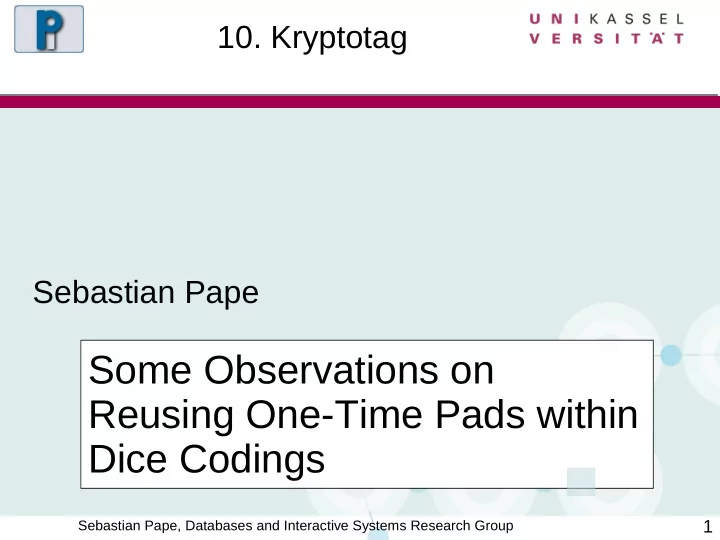

10. Kryptotag Sebastian Pape Some Observations on Reusing One-Time Pads within Dice Codings 1 Sebastian Pape, Databases and Interactive Systems Research Group
Overview ● Dice Codings ● Invalid Keys ● Attacking the Key Pad ● Countermeasures 2 Sebastian Pape, Databases and Interactive Systems Research Group
Introduction / Scenario ● Scope: Online-Banking ● Computer is controlled by attacker ● Visual Cryptography ● Key-transparencies are used in conjunction with monitor 3 Sebastian Pape, Databases and Interactive Systems Research Group
Introduction / Visual Coding ● Digits: From [DD08] ● Not complete: From [DD08] 4 Sebastian Pape, Databases and Interactive Systems Research Group
Dice Codings From [DD08] ● Identity / NOT XOR From [DD08] 5 Sebastian Pape, Databases and Interactive Systems Research Group
Dice Codings Example From [DD08] 6 Sebastian Pape, Databases and Interactive Systems Research Group
Invalid Keys (10 dices) ● Number of points per segment: 9 ● Keysize for 10 segments: 90 ≈ 1,23 ∗ 10 27 2 ● Valid keys: From [DD08] 0 ∗ 1 ∗∗ 9 ∗ 10 ! ≈ 4,26 ∗ 10 9 9 9 19 2 66 Quotient: valid keys − 8 number of keys ≈ 3 ∗ 10 7 Sebastian Pape, Databases and Interactive Systems Research Group
Invalid Keys (2 dices) ● Number of points per segment: 9 18 2 ● Keysize for 2 segments: ● Invalid keys per Ciphertext: 0 1 9 9 i 2 2 2 2 9 9 9 9 = ∑ = 48.620 i = 0 invalid keys number of keys = 48.620 262.144 ≈ 18,5% ● Quotient: 8 Sebastian Pape, Databases and Interactive Systems Research Group
Questions ● Is it possible to extract the OTP / key- transparency? ⇒ almost ● d(Cipher, key) → ● d(Cipher, inverse(key)) → ● So, how many ciphertexts do we need? 9 Sebastian Pape, Databases and Interactive Systems Research Group
Algorithm's Idea ● Keep track of invalid keys – Binary Decision Tree with half of all possible keys – Delete invalid keys – Until only one key is left ● Result: Secret Key or its inverse 17 ● Runtime: Several times =131.072 2 10 Sebastian Pape, Databases and Interactive Systems Research Group
Test Data (Ciphers) ● 20.000 runs 800 700 ● 70 ciphers >= 60% 600 500 ● 90 ciphers >= 95% 400 300 200 100 0 0 20 40 60 80 100 120 140 160 180 11 Sebastian Pape, Databases and Interactive Systems Research Group
Test Data (CPU time(s)) ● 20.000 runs 2000 1800 ● 1 Core 3.00GHz 1600 (Intel E8400) 1400 ● Feasible 1200 1000 ● Victims CPU can 800 be used 600 400 200 0 0 10 20 30 40 50 60 12 Sebastian Pape, Databases and Interactive Systems Research Group
Global View ● Easy Implementation: Run Algorithm 5 times (pairs: 0+1, 2+3, ..., 8+9) ● But: we have 45 pairs and as soon as parts of the key are recovered additional information is gained ● Not tested in practice ● Complete key or its inverse is recovered 13 Sebastian Pape, Databases and Interactive Systems Research Group
Countermeasures ● More points on the dices (0 to n) ● More dices (lower restrictions) ● Similar procedure to iTAN (lower restrictions) 14 Sebastian Pape, Databases and Interactive Systems Research Group
Number of Points ● Number of points per segment: n 2n 2 ● Keysize for 2 segments: ● Invalid keys per Ciphertext: n i 2 = 2n ! n ∑ n ! n ! (using Vandermonde's identity) i = 0 2n ! 1 2n (using Stirling's formula) n ! n !≈ n 2 invalid keys 1 number ob keys ≈ ● Quotient: n ● Bad impact on UI 15 Sebastian Pape, Databases and Interactive Systems Research Group
Number of Dices ● 0 additional dices: 18 – 18,5% invalid keys, keysize: 2 ● 1 additional dice (1 doubled dice allowed): 27 2 – 3,9% invalid keys, keysize: ● 2 additional dices (1 tripple dice allowed): 36 2 – <1% invalid keys, keysize: 0 1 9 9 i 2 a 2 a 2 a 2 a 9 9 9 9 = ∑ ● i = 0 ● Impact on UI 16 Sebastian Pape, Databases and Interactive Systems Research Group
Similar to iTAN ● Ask for a specific TAN ● Allows to add more redundancy ● Only 4 (6) Digits have to be contained ● Worst case: (digits: 0189) 24 3,76 ∗ 10 ● Versus: 90 ≈ 1,23 ∗ 10 27 2 ● But now any combination can be possible ● Statistical attacks? / digits 0,9 expose key 17 Sebastian Pape, Databases and Interactive Systems Research Group
Conclusions ● It is possible to attack Dice Codings if the key-transparency is used multiple times ● By Improvements attack can be countered ● Procedure similar to iTan may solve this and is probably acceptable by users ● Statistical attack may be possible ● User manipulation not regarded here – Influence User (0,9) to leak parts of the key 18 Sebastian Pape, Databases and Interactive Systems Research Group
Thank you for your attention 19 Sebastian Pape, Databases and Interactive Systems Research Group
References ● [DD08] Denise Doberitz, Complete Codings for Visual Cryptography, 9. Kryptotag, Gelsenkirchen 20 Sebastian Pape, Databases and Interactive Systems Research Group
Recommend
More recommend